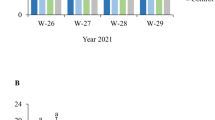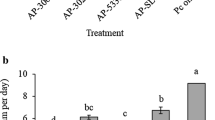Abstract
The effect of different fungicide programs on grey mould (caused by Botrytis cinerea) and stem-end rot (caused by Gnomoniopsis fructicola) affecting strawberry plants (Fragaria ×ananassa cv. Festival) was studied in subtropical Australia over three years. The treatments involved a range of different synthetic multi- and single-site fungicides with different modes of action, a plant-defence promoter, plant extracts (lupin and rhubarb), organic acids, fatty acids, a salt, two strains of Bacillus subtilis, and single strains of B. amyloliquefaciens, Streptomyces lydicus and Trichoderma harzianum. Standard programs based on captan and thiram alternated, and applied with iprodione, fenhexamid, cyprodinil + fludioxonil, and penthiopyrad resulted in 3–4 % of unmarketable fruit compared with 25–38 % in the water-treated controls. There was no difference in the level of disease suppression when five or thirteen applications of single-site fungicides were rotated with the two multi-site fungicides. The incidence of unmarketable fruit was similar to the standard programs using isopyrazam (in 1 year out of 2), or penthiopyrad, fluazinam, chlorothalonil or thiram alone (in 1 year out of 1). The other fungicide programs were generally less effective. There were strong relationships between marketable yield and the incidence of unmarketable fruit over the three years (R2s = 0.82–0.93). A strategy based on thiram and captan applied alternately, with reduced applications of single-site fungicides is recommended and should reduce the chance of resistance to single-site fungicides becoming widespread in populations of the grey mould fungus. Although the program based on thiram alone had a similar incidence of unmarketable fruit as the standard program, repeated weekly applications of thiram are not recommended as they may cause unacceptable residues in the fruit. There were issues with some of the other fungicides due to phytotoxicity, residues, or difficulties with registering new fungicides that are in the same chemical group as currently registered products.

Similar content being viewed by others
References
Alabouvette C, Olivain C, Steinberg C (2006) Biological control of plant diseases: the European situation. Eur J Plant Pathol 114:329–341
Alexopoulos CJ, Cation D (1948) Stem-end rot of strawberries. Phytopathology 38:698–706
Alexopoulos CJ, Cation D (1952) Gnomonia fragariae in Michigan. Mycologia 44:221–223
Amiri A, Heath SM, Peres NA (2013) Phenotypic characterization of multifungicide resistance in Botrytis cinerea from strawberry fields in Florida. Plant Dis 97:393–401
Balode A (2014) Evaluation of microbiological products to control grey mould in strawberries. Acta Hortic 1053:85–90
Bestfleisch M, Luderer-Pfimpfl M, Höfer M, Schulte E, Wünsche JN, Hanke M-V, Flachowsky H (2015) Evaluation of strawberry (Fragaria L.) genetic resources for resistance to Botrytis cinerea. Plant Pathol 64:396–405
Bolton AT (1954) Gnomonia fruiticola on strawberry. Can J Bot 32:172–181
Bristow PR, McNicol RJ, Williamson B (1986) Infection of strawberry flowers by Botrytis cinerea and its relevance to grey mould development. Ann Appl Biol 109:545–554
Brun PG, Sutton JC (1987) Inoculum sources of Botrytis cinerea in fruit rot of strawberries in Ontario. Can J Plant Pathol 9:1–5
Calvo-Garrido C, Elmer PAG, Parry FJ, Viñas I, Usall J, Torres R, Agnew RH, Teixidó N (2014) Mode of action of a fatty acid-based natural product to control Botrytis cinerea in grapes. J Appl Microbiol 116:967–979
de los Santos B, Barrau C, Romero F (2003) Strawberry fungal diseases. J Food Agric Environ 1:129–132
Elad Y, Stewart A (2004) Microbial control of Botrytis spp. In: Elad Y, Williamson B, Tudzynski P, Delen N (eds) Botrytis: biology, pathology and control. Kluwer Academic Publishers, Dordrecht, pp. 223–241
Elmer PAG, Reglinski T (2006) Biosuppression of Botrytis cinerea in grapes. Plant Pathol 55:155–177
Faby R (2014) Control of botrytis fruit rot – influence of floral stage and number of chemical sprayings. Acta Hortic 1049:621–626
Fernández-Ortuño D, Grabke A, Bryson PK, Amiri A, Peres NA, Schnabel G (2014) Fungicide resistance profiles in Botrytis cinerea from strawberry fields of seven southern U.S. states. Plant Dis 98:825–833
Grabke A (2015) A Botrytis cinerea population from a single strawberry field in Germany has a complex fungicide resistance pattern. Plant Dis 99:1078–1086
Grabke A, Fernández-Ortuño D, Amiri A, Li XP, Peres NA, Smith P, Schnabel G (2014) Characterization of iprodione resistance in Botrytis cinerea from strawberry and blackberry. Phytopathology 104:396–402
Gubler WD, Feliciano AJ (1999) Occurrence of leaf blotch and stem-end rot of strawberry in the central coast of California. Plant Dis 83:199
Hirooka T, Ishii H (2013) Chemical control of plant diseases. J Gen Plant Pathol 79:390–401
Hu MJ, Schnabel G (2016) Fungicide resistance in Botrytis cinerea: a challenge for conventional small fruit production. Acta Hortic 1133:503–506
Hyakumachi M (2013) Research on biological control of plant diseases: present state and perspectives. J Gen Plant Pathol 79:435–440
Jarvis WR (1962) The infection of strawberry and raspberry fruits by Botrytis cinerea Fr. Ann Appl Biol 50:569–575
Keats A (2013) Determination of thiram residues in strawberry fruit following three applications of thiram fungicide. Final Report for Horticulture Australia Inc (BS12204)
Legard DE, Xiao CL, Mertely JC, Chandler CK (2001) Management of botrytis rot in annual winter strawberry using captan, thiram, and iprodione. Plant Dis 85:31–39
Leroux P (2004) Chemical control of Botrytis and its resistance to chemical fungicides. In: Elad Y, Williamson B, Tudzynski P, Delen N (eds) Botrytis: biology, pathology and control. Kluwer Academic Publishers, Dordrecht, pp. 195–222
Maas JL (1998) Compendium of strawberry diseases. APS Press, Inc., St Paul, pp. 38–39
Mackenzie SJ, Peres NA (2012) Use of leaf wetness and temperature to time fungicide applications to control botrytis fruit rot of strawberry in Florida. Plant Dis 96:529–536
Marquardt DW (1963) An algorithm for least squares estimation of parameters. J Soc Industrial Appl Math 11:431–441
Menzel CM, Smith LA (2012) Relationship between the levels of non-structural carbohydrates, digging date, nursery-growing environment, and chilling in strawberry transplants in a subtropical environment. Hortscience 47:459–464
Menzel CM, Smith LA, Moisander JA (2014) The productivity of strawberry plants growing under high plastic tunnels in a wet subtropical environment. HortTechnology 24:334–342
Menzel CM, Smith LA, Moisander JA (2016) Protected cropping of strawberry plants in subtropical Queensland. Acta Hortic 1117:273–278
Mohammadi S, Aroiee H, Aminifad MH, Tehranifar A, Jahanbakhsh V (2014) Effect of fungicidal essential oils against Botrytis cinerea and Rhizopus stolonifer rot in vitro conditions. Arch Phytopathol Plant Prot 47:1603–1610
Moročko I, Fatehi J (2007) Molecular characterization of strawberry pathogen Gnomonia fragariae and its genetic relatedness to other Gnomonia species and members of Diaporthales. Mycol Res 111:603–614
Powelson RL (1960) Initiation of strawberry fruit rot caused by Botrytis cinerea. Phytopathology 50:491–494
Romanazzi G, Smilanick J, Feliziani E, Droby S (2016) Integrated management of postharvest gray mold on fruit crops. Postharvest Biol Tech 113:69–75
Shipton PJ (1967) A fruit rot of strawberries caused by Zythia fragariae. Plant Pathol 16:123–125
Suzuki H, Kuroda K, Minato Y (2011) Efficacy of fungicides in controlling Botrytis cinerea. Annual Rep Kansai Plant Prot Soc 53:13–19
Sylla J, Alsanius BW, Krüger E, Wohanka W (2015) Control of Botrytis cinerea in strawberries by biological control agents applied as single or combined treatments. Eur J Plant Pathol 143:461–471
Terry LA, Joyce DC (2000) Suppression of grey mould on strawberry fruit with the chemical plant activator acibenzolar. Pest Management Sci 56:989–992
Thomidis T, Pantazis S, Navrozidis E, Karagiannidis N (2015) Biological control of fruit rots on strawberry and grape by BOTRY-Zen. N Z J Crop Hortic Sci 43:68–72
Washington WS, Shanmuganathan N, Forbes C (1992) Fungicide control of strawberry fruit rots, and the field occurrence of resistance of Botrytis cinerea to iprodione, benomyl and dichlorofluanid. Crop Prot 11:355–360
Washington WS, Engleitner S, Boontjes G, Shanmuganathan N (1999a) Effect of fungicides, seaweed extracts, tea tree oil, and fungal agents on fruit rots and yield in strawberry. Aust J Exp Agric 39:487–494
Washington WS, Engleitner S, Shanmuganathan N (1999b) The effect of longer spray intervals, reduced rates, or mixtures of three fungicides on fruit rots in strawberry. Plant Prot Quart 14:88–91
Weber RWS (2011) Resistance of Botrytis cinerea to multiple fungicides in northern German small-fruit production. Plant Dis 95:1263–1269
Wedge DE, Curry KJ, Kreiser B, Curry A, Arbil M, Smith BJ (2013) Fungicide resistance profiles for 13 Botrytis cinerea isolates from strawberry in southeastern Louisiana. Internat J Fruit Sci 13:413–429
Whitaker VM, Price JF, Peres NA, Folta KM, Noling JW (2014) Current strawberry research at the University of Florida. Acta Hortic 1049:161–166
Williamson B, Tudzynski B, Tudzynski P, van Kan JAL (2007) Botrytis cinerea: the cause of grey mould disease. Mol Plant Pathol 8:561–580
Wu JX, Liu ZL, Pan CP, Zhao YZ, Zhang HY (2014) Residue analysis and dissipation of fluazinam in apple under field conditions. Asian J Chem 26:6758–6760
Yin DF, Wu SS, Liu N, Yin Y, Ma ZH (2016) The natural fenhexamid-resistant grey mould populations from strawberry in Zhejiang Province are dominated by Botrytis cinerea group S. Pest Management Sci 72:1540–1548
Zaker M (2014) Anti-fungal evaluation of some inorganic salts against three phytopathogenic fungi. Internat J Agric. Crop Sci 7:1352–1358
Acknowledgments
We thank Horticulture Innovation Australia Limited and the Queensland Strawberry Growers’ Association for supporting this research, and Dr. Natalia Peres from the University of Florida for comments on the paper. The Queensland Government co-funded this research through the Department of Agriculture and Fisheries.
Author information
Authors and Affiliations
Corresponding author
Rights and permissions
About this article
Cite this article
Menzel, C.M., Gomez, A. & Smith, L.A. Control of grey mould and stem-end rot in strawberry plants growing in a subtropical environment. Australasian Plant Pathol. 45, 489–498 (2016). https://doi.org/10.1007/s13313-016-0440-5
Received:
Accepted:
Published:
Issue Date:
DOI: https://doi.org/10.1007/s13313-016-0440-5




